
Quiz on key musical elements
- Subject:
- Arts and Humanities
- Performing Arts
- Material Type:
- Interactive
- Provider:
- Michigan Virtual
- Date Added:
- 12/13/2018

Quiz on key musical elements

Students demonstrate expressive qualities of music through movement.
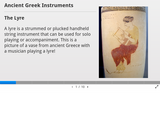
Slideshow of ancient instruments
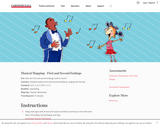
Students explore first and second endings by singing and moving.
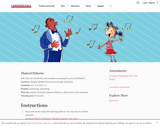
Students identify musical form through movement.
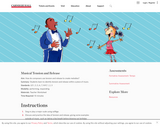
Students learn to identify tension and release within a piece of music.
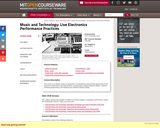
This course is a creative, hands-on exploration of contemporary and historical approaches to live electronics performance and improvisation, including basic analog instrument design, computer synthesis programming, and hardware and software interface design.
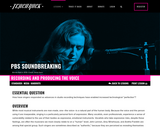
There are many who believe that "less is more" when it comes to using technology. This is the heart of the debate around recording vocals in music: how much manipulation is too much? If recording engineers and producers can use computers and software to digitally alter a vocal track, what happens to the original voice, and what role does talent play? To many, there is a fine line between the "perfection"that can be achieved with technology and the experience of "authenticity" in a recorded vocal performance. This lesson explores the ways in which music technology can enhance a singer's performance. It also considers the listener's interest in hearing the "authenticity" of a vocal performance. Either way, the heart of most popular music is the same, important center: the human voice.
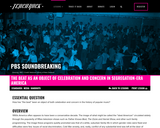
As the lesson unfolds, students will get to investigate some of the ways listeners feel and relate to rhythms, focusing on the language used to describe "the beat," and the manners in which rhythms connect to a deeper past and seem to anticipate particular futures. If "the beat" was a concern in 1950s America, it was again a concern for some, decades later, when Gangsta Rap began to dominate the Billboard charts. How far have we come? And how can we study the past to learn more about the future we're making and the music we'll make it with? This lesson gets to the heart of the conflicts that arise as particular rhythms get made, released, listened to, and loved.
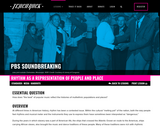
This lesson explores several strands of the musical "DNA" that make up the beat of popular music. Looking to the past, this lesson asks what it means to call music "Afro-Cuban" "Afro-Caribbean," or more broadly, "African-American." Students will use Soundbreakingclips of Santana and Beyonce and the Soundbreaking Rhythmic Layers TechTools to locate in American popular music influences stemming from the African-American church, Latin America and West Africa. Students will then explore the ways "the beat" of this music has, to some listeners, been perceived as "dangerous" while, for others, it is believed that music has been able to challenge obstacles of racism and segregation, bringing people from varied ethnic groups and lifestyles together in ways that words and laws could not.
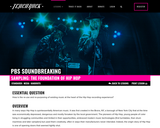
In this lesson students explore the creative concepts and technological practices on which Hip Hop music was constructed, investigating what it means to "sample" from another style, who has used sampling and how. Then, students experience the technology first hand using the Soundbreaking Sampler TechTool. Students will follow patterns of Caribbean immigration and the musical practices that came to New York City as a result of those patterns, finally considering the ways in which Hip Hop reflects them. Moving forward to the late 1980s and early 90s, what some consider Hip Hop's "Golden Age," this lesson explores how sampling might demonstrate a powerful creative expression of influence or even a social or political statement. Finally, this lesson encourages students to consider the conceptual hurdle Hip Hop asked listeners to make by presenting new music made from old sounds.
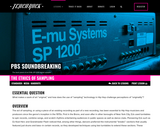
In this lesson, students use examples from visual art as well as rap to enter into a "structured academic controversy" that explores the concept of originality.
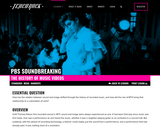
The 24-hour-a-day music video programming of MTV gave musicians and their audiences a platform to fully explore the experience of sound and image. In this lesson, students will investigate the ways musicians used video before MTV, then consider how MTV changed the way artists have exploited the surprising territory where sound meets image.

In this lesson, students follow the life journey of Blues musician McKinley "Muddy Waters" Morganfield, from his early beginnings in rural Mississippi to his music career in Chicago, Illinois. In learning about Waters' life, students consider the ways new environments might inspire people to express themselves in different ways. Students then reflect on ways new experiences might have spurred their own personal growth by creating a life roadmap.
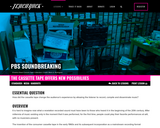
This lesson explores the possibilities created by the new technology of cassettes and how people made use of them. In many ways, the digital future and its interactive possibilities were prefigured by the cassette era. By viewing and discussing clips from Soundbreaking Episode Eight, students learn how the Grateful Dead allowed their fans to tape their concerts and freely trade cassettes of their recordings, a move that helped establish the group as innovators in how bands cultivate relationships with their fanbase. Students will also consider how the cassette allowed individuals to express themselves through the selection, sequencing and re-packaging of commercially released music. In the last part of the lesson, they will look at the Sony Walkman and related devices, the first portable cassette players that led toward the current age of iPods, Mp3 players, and other forms of personal digital listening devices, exploring a period in which the boundaries between "consumer" and "producer," and "fan" and "participant" began to erode, allowing even the casual music fan a degree of access to the creative process.

In this lesson, Gospel music is used as a way to introduce students to the rhythmic concepts of beat, meter, backbeat, subdivision, and syncopation. By clapping and counting along to videos of Mahalia Jackson, Sam Cooke, Sister Rosetta Tharpe, The Staple Singers, and Beyonce, students practice hearing and identifying these various aspects of rhythm. Students will also use an interactive TechTool to gain a deeper understanding of the syncopated rhythms that allows Gospel, as well a popular music in general, inspire us to move.
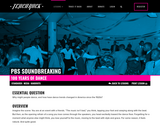
In this lesson, students investigate these questions by analyzing videos of dancing through the decades. With the help of a worksheet, student groups watch footage of the Charleston and Lindy Hop, the Mambo, "Love-in" dancing, Disco, and Break Dancing. Based on their informed observation of these styles, they then debate whether dance has "evolved" in American culture, or remained mostly the same.

Taking Sam Phillips as a case study, this lesson explores the role of the producer in the recording studio as one defined by an ability to guide the recording process but also to affect the wider cultural context. After investigating what a producer does and why an artist might benefit from a producer's services, this lesson looks at the way Sam Phillips' approach in some ways reflects the trend of urbanization in the American South. Like Phillips, many of his artists came from rural backgrounds and were seeking the benefits of urban life. That move toward the urban, and the racial mixing it fostered, was almost encoded in the music, as the lesson activities will illuminate. Finally, the lesson looks at Phillip's guidance of a young Elvis Presley and suggests how the music they produced created an opening for African-American music to "crossover" into mainstream American popular music.
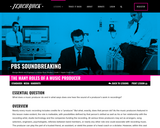
Phil Spector and George Martin both created defining sounds of the 1960s, but, inevitably, as music and culture changed, so too did some musicians' ideas about allowing producers to exert control over their music. Some of the Singer-Songwriters of the early 1970s, such as Joni Mitchell, accepted little or no input from producers, focusing on the clarity and directness of the lyrics with sometimes minimal musical accompaniment. In the latter part of this lesson, students use a handout with information about both Betty Friedan's seminal The Feminine Mystique and events in 1960s Second-Wave Feminism as a backdrop by which to consider Joni Mitchell's decision to "self-produce"in the early 1970s.
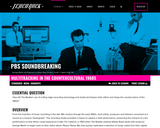
To many, the sense of limitless possibility The Beatles arrived at while working inside Abbey Road Studios was part of a broader pattern of change connected to the 1960s countercultural movement. Political and social events, including student protests against the Vietnam War, a popular interest in the study of Eastern religions, and the publication of books such as 1964's The Psychedelic Experience, helped to inform The Beatles' musical decisions as much as the music the group invented fueled the rise of a new youth culture. The Beatles provided the soundtrack to a new experience. As popular icons that challenged social norms and encouraged creative thinking, recording artists like The Beatles began using multitracking technology to make music in the studio that could not be reproduced on the concert stage and that expanded our understanding of what popular music could be and what it could do. The studio was no longer a predictable space for recording live performances; it became a laboratory for constructing sophisticated musical imaginings. As such, it was a perfect reflection of the new youth culture's spirit.